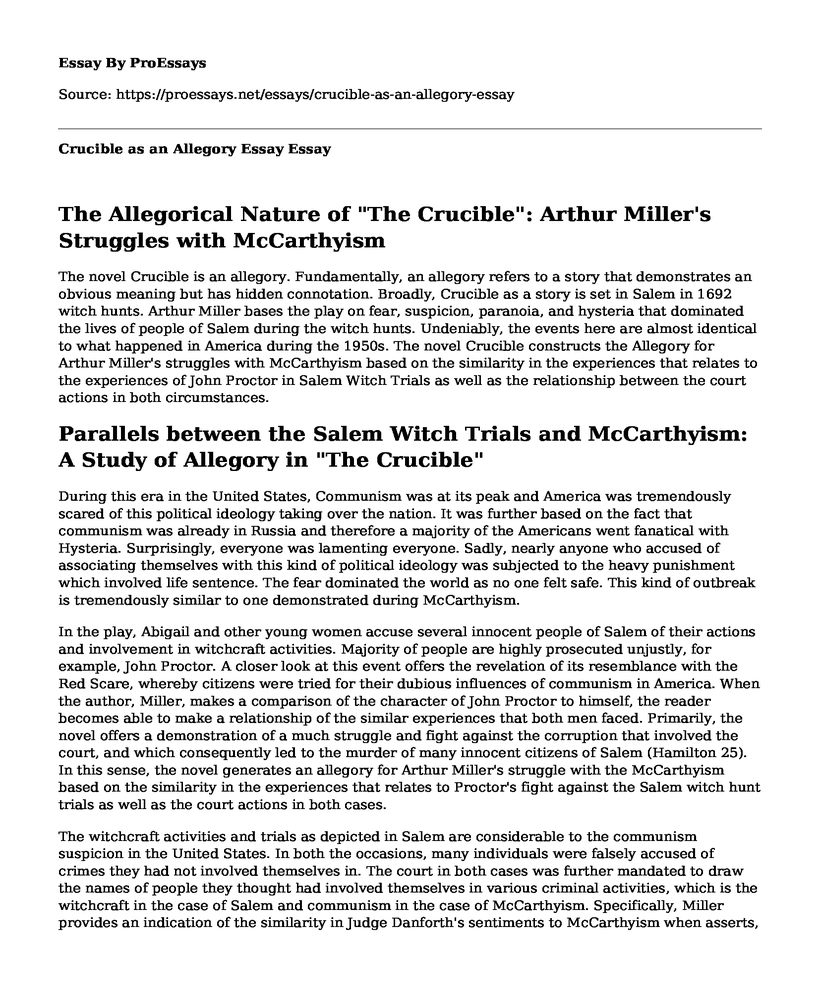The Allegorical Nature of "The Crucible": Arthur Miller's Struggles with McCarthyism
The novel Crucible is an allegory. Fundamentally, an allegory refers to a story that demonstrates an obvious meaning but has hidden connotation. Broadly, Crucible as a story is set in Salem in 1692 witch hunts. Arthur Miller bases the play on fear, suspicion, paranoia, and hysteria that dominated the lives of people of Salem during the witch hunts. Undeniably, the events here are almost identical to what happened in America during the 1950s. The novel Crucible constructs the Allegory for Arthur Miller's struggles with McCarthyism based on the similarity in the experiences that relates to the experiences of John Proctor in Salem Witch Trials as well as the relationship between the court actions in both circumstances.
Parallels between the Salem Witch Trials and McCarthyism: A Study of Allegory in "The Crucible"
During this era in the United States, Communism was at its peak and America was tremendously scared of this political ideology taking over the nation. It was further based on the fact that communism was already in Russia and therefore a majority of the Americans went fanatical with Hysteria. Surprisingly, everyone was lamenting everyone. Sadly, nearly anyone who accused of associating themselves with this kind of political ideology was subjected to the heavy punishment which involved life sentence. The fear dominated the world as no one felt safe. This kind of outbreak is tremendously similar to one demonstrated during McCarthyism.
In the play, Abigail and other young women accuse several innocent people of Salem of their actions and involvement in witchcraft activities. Majority of people are highly prosecuted unjustly, for example, John Proctor. A closer look at this event offers the revelation of its resemblance with the Red Scare, whereby citizens were tried for their dubious influences of communism in America. When the author, Miller, makes a comparison of the character of John Proctor to himself, the reader becomes able to make a relationship of the similar experiences that both men faced. Primarily, the novel offers a demonstration of a much struggle and fight against the corruption that involved the court, and which consequently led to the murder of many innocent citizens of Salem (Hamilton 25). In this sense, the novel generates an allegory for Arthur Miller's struggle with the McCarthyism based on the similarity in the experiences that relates to Proctor's fight against the Salem witch hunt trials as well as the court actions in both cases.
The witchcraft activities and trials as depicted in Salem are considerable to the communism suspicion in the United States. In both the occasions, many individuals were falsely accused of crimes they had not involved themselves in. The court in both cases was further mandated to draw the names of people they thought had involved themselves in various criminal activities, which is the witchcraft in the case of Salem and communism in the case of McCarthyism. Specifically, Miller provides an indication of the similarity in Judge Danforth's sentiments to McCarthyism when asserts, Mr. Proctor, When the devil approached you, were you able to notice Rebecca Nurse in his group?" (p. 129). Interestingly, this implies that the courts in both the events, in Crucible and McCarthyism were only able to hear your testimony just if you had to mention other innocent members of the society. In the novel, Miller quotes, "You must have no fear to tell us who they are, do you understand? We will protect you." (Miller 43). Similar experiences can further relate to the events that occurred after the establishment of the House Un-American Activities Committee (HUAC), which was created in 1938 with the role of investigating the alleged disloyalty and subversive activities on private citizens and organizations who were suspected of associating with Fascists and Communists ideologies.
Conclusion
In conclusion, the novel Crucible constructs the Allegory for Arthur Miller's struggles with McCarthyism based on the similarity in the experiences that relates to the experiences of John Proctor in Salem Witch Trials as well as the relationship between the court actions in both circumstances. Undeniably, Miller has succeeded in generating an allegory from the McCarthyism to the experiences he had. He is further able to develop a relationship of the court actions.
Works Cited
Hamilton, Craig. "Allegory, blending, and censorship in modern literature." Journal of Literary Semantics 40.1 (2011): 23-42.
Miller, Arthur. The Crucible. Oxford: Heinemann, 1992. Print.
Cite this page
Crucible as an Allegory Essay. (2022, Mar 27). Retrieved from https://proessays.net/essays/crucible-as-an-allegory-essay
If you are the original author of this essay and no longer wish to have it published on the ProEssays website, please click below to request its removal:
- The Effectiveness of Mark Antony or Marcus Brutus Speech
- Discussion Thread: "You Fit Into Me" and "Rite of Passage"
- Literary Analysis Essay on Twain Adventures of Huckleberry Finn: Huck Finn and Jim's Relationship
- The Role of Fate in the Iliad Essay Example
- Essay Sample on Creature in Frankenstein: Excluded and Abominated?
- Frankenstein: How Novels Impact Pop Culture and Science - Essay Sample
- Paper Example on Fish Cheeks: Amy Tan's Crushing Fear of Rejection







